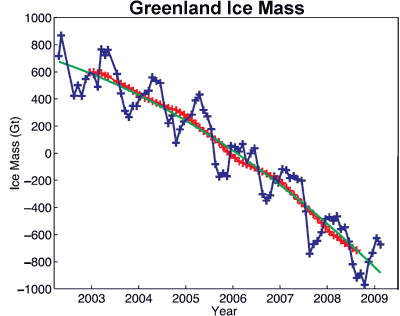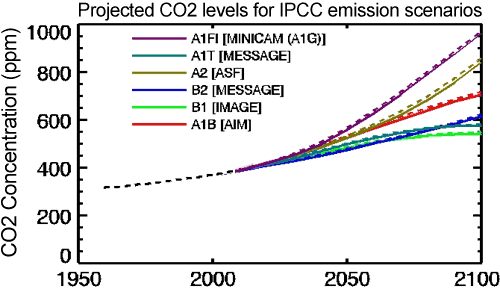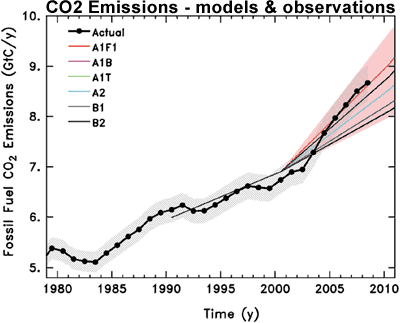What CO2 level would cause the Greenland ice sheet to collapse?
Posted on 23 March 2010 by John Cook
A matter of concern is the potential instability of the Greenland and Antarctic ice sheets. If the Greenland ice sheet was to completely collapse, it would contribute as much as 7 metres sea level rise. Similarly, the West Antarctic ice sheet would contribute around 6 metres sea level rise. East Antarctica would contribute 70 metres of sea level rise but is less prone to collapse. Consequently, how these ice sheets respond to warming temperatures is a crucial area of research. A new paper () has been published that estimates that the CO2 level that will lead to collapse of the Greenland ice sheet is between 400 to 560 parts per million (ppm). At our current rate, we should pass 400 ppm within 10 years.
While there are uncertainties over the specifics of ice sheet behaviour, there are several lines of independent evidence that paint a consistent picture of how ice sheets will respond to global warming. Focusing on Greenland, what do observations tell us has been happening to the Greenland ice sheet? Satellites use gravity data to measure the total mass balance and have found the ice sheet is losing ice mass at an accelerating rate (Velicogna 2009).

Figure 1: Ice mass changes for the Greenland ice sheet estimated from GRACE satellite measurements. Unfiltered data are blue crosses. Data filtered for the seasonal dependence are shown as red crosses. The best-fitting quadratic trend is shown as a green line (Velicogna 2009).
How can we know how the Greenland ice sheet will behave over a longer time period? We can determine this by looking at how the ice sheet has responded in the past. Some of the more optimistic emission scenarios from the IPCC predict warming of 1 to 2°C. The last time temperatures were this high were 125,000 years ago. At this time, sea levels were over 6 metres higher than current levels (Kopp 2009). This tells us that the Greenland and Antarctic ice sheets are highly sensitive to sustained, warmer temperatures and that in upcoming centuries, we can expect sea level rise in the range of metres, not centimetres.
Further light is shed on Greenland ice sheet stability in a new paper The effect of more realistic forcings and boundary conditions on the modelled geometry and sensitivity of the Greenland ice-sheet
Although not completely collapsed, the 400 ppm ice-sheet loses ice mass in the north of the island, with a total reduction in ice volume ranging between 20 to 41%. Note - due to the large inertia of the Greenland ice sheet, this mass loss doesn't happen at the moment CO2 levels reach 400 ppm but over a period of centuries. Under a 560 ppm climate, the Greenland ice sheet loses between 52 to 87% of its ice volume. If CO2 reaches 1120 ppm, there is almost complete elimination of the Greenland ice sheet with loss between 85 to 92%. The important result from this paper is that there is a critical threshold where the Greenland ice sheet becomes unstable somewhere between 400 and 560 ppm.
This is a large uncertainty range and one imagines there will be much research in the next few years to reduce the uncertainty. However, the 400 to 560 ppm range is put into perspective when you look at the projected CO2 levels for the various IPCC scenarios. The business as usual scenario has CO2 levels reaching 1000 ppm by 2100. Even the most optimistic scenario tops 500 ppm by 2100.

Figure 3: Atmospheric CO2 concentrations as observed at Mauna Loa from 1958 to 2008 (black dashed line) and projected under the 6 IPCC emission scenarios (solid coloured lines). (IPCC Data Distribution Centre)
Of course, Figure 3 displays projected scenarios. What has been happening in the real world? Observed CO2 emissions in recent years have actually been tracking close to or above the worst case scenario.

Figure 4: Observed global CO2 emissions from fossil fuel burning and cement production compared with IPCC emissions scenarios. The coloured area covers all scenarios used to project climate change by the IPCC (Copenhagen Diagnosis).
Satellite measurements, paleoclimate data and ice sheet modelling all paint a consistent picture. Global warming is destabilising the Greenland ice sheet which is highly sensitive to sustained warmer temperatures. Our current trajectory with CO2 emissions will likely cause at least several metres sea level rise from the Greenland ice sheet over the next few centuries. Of course, we shouldn't forget that this estimate doesn't include Antarctica - the Antarctic ice sheet is also losing ice at an accelerating rate.































 Arguments
Arguments

























 0
0  0
0






Comments